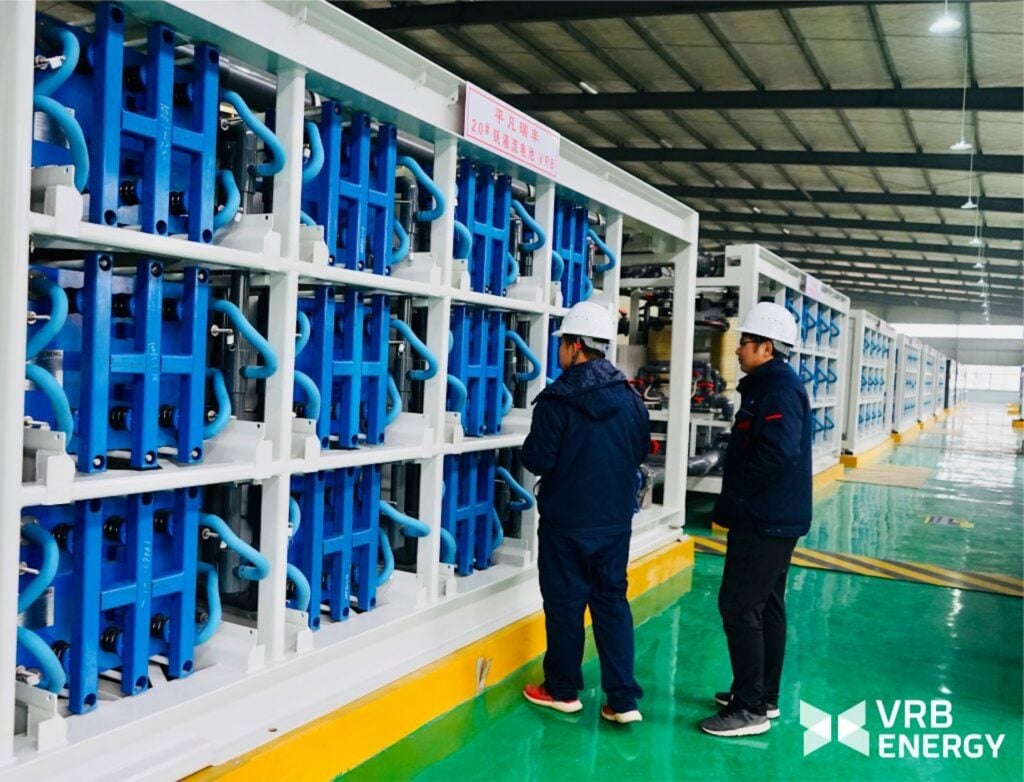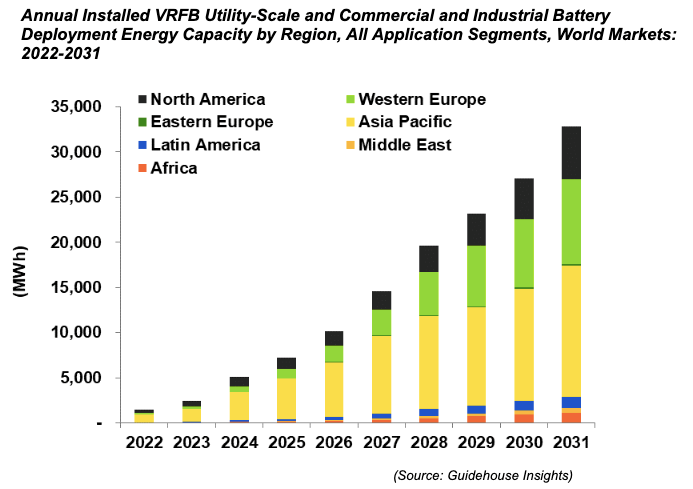
Cell stacks at a large-scale VRFB demonstration plant in Hubei, China. Image: VRB Energy.
The vanadium redox flow battery (VRFB) industry is poised for significant growth in the coming years, equal to nearly 33GWh a year of deployments by 2030, according to new forecasting.
Vanadium industry trade group Vanitec has commissioned Guidehouse Insights to undertake independent analysis of the VRFB energy storage sector. These have been collected in a white paper, “Vanadium redox flow batteries: Identifying opportunities and enablers”.
The research and market intelligence firm found that while lithium-ion dominates global energy storage deployments today by market share, various attributes of VRFBs make them a promising option in tandem with existing chemistries.
Advantages include the long lifespan and durability of VRFBs, their low operating costs, non-flammable design and a low environmental impact, both in manufacturing and in operation. Meanwhile, they can meet the needs of developers that require long-duration energy storage and can be operated with minimal maintenance for a 20-year lifespan, Guidehouse said.
Major R&D efforts have been made into thetechnology invented at the University of New South Wales in Australia, by both private and public companies and institutions since patents began expiring in the early 2000s.
Guidehouse noted however that despite the progress and attractive features of VRFBs, commercial challenges that have prevented them from take-off persist.
VRFBs have a higher capital cost than lithium-ion battery energy storage system (BESS) technology but can offer a lower cost of ownership and levelised cost of energy storage over their lifetime. Yet this detail is often missed when procurement decisions are made.
There is also what the analysts described as an over-reliance on lithium in the market today, but if VRFB manufacturing and deployment can scale up, continuous growth in the industry could be unlocked.
 Forecasted CAGR of VRFB deployments worldwide. Image: Vanitec / Guidehouse Insights.
Forecasted CAGR of VRFB deployments worldwide. Image: Vanitec / Guidehouse Insights.Forecasting a healthy growth trajectory for VRFBs
The white paper picked up on a couple of major projects that it said was evidence of growing interest in flow batteries internationally.
These were a 800MWh project in China by Rongke Power/UniEnergy that is scheduled to come online this year and a 200MWh project in South Australia which is in development through manufacturer CellCube, while the biggest VRFB installation in the world today is a 15MW/60MWh system brought online in northern Japan by maker Sumitomo Electric a few years ago.
Revenues from VRFB project deployments are expected to be worth about US$850 million this year and projected to rise to US$7.76 billion by 2031.
That means annual global deployments of an estimated 32.8GWh per year by that later year and a compound annual growth rate of 41% in the market over this decade.
In terms of regions, Guidehouse expects Asia-Pacific to lead installation figures, with Western Europe and North America the other top global regions. Asia-Pacific deployments are predicted to reach about 14.5GWh annually, Western Europe about 9.3GWh and North America about 5.8GWh according to the white paper.
Vanadium is currently used in a number of industries, with the biggest share today being as an additive that can greatly strengthen steel alloys used in construction with even just a small amount of vanadium added.
As wenoted in an article last year for the journalPV Tech Power, there are however only three primary vanadium producers in the world, with the majority of vanadium coming from secondary sources as a byproduct of steel production.
That said, there are efforts ongoing to create bigger resources of vanadium feedstock, not least of all inAustralia where financial support has been extendedto companies looking to extract vanadium from the ground and turn it into electrolyte.
Guidehouse Insights forecasts that the growth of VRFBs will be such that by 2031, between 127,500 and 173,800 tonnes of new vanadium demand will be created, equivalent to double the demand for the metal today.
The electrolyte constitutes around 30% to 50% of the total system cost of a VRFB energy storage project, which Guidehouse noted is the highest percentage cost for a key mineral in any type of battery. However, the batteries could be capable of 10,000 to 20,000 cycles during their lifetime without requiring rest periods or experiencing capacity degradation, which raises their operational availability versus an average of around 3,000 cycles for Li-ion batteries.
The paper does acknowledge some of the technology’s downsides, albeit whilst pointing out that the industry is working to address those, such as: lower round-trip efficiency (flow batteries average 70% to 85%, versus 90% to 95% for Li-ion), lower energy density and therefore larger footprint and the most pressing barrier, the need to “substantially reduce costs,” in light of the technology’s vulnerability to spikes in the price of vanadium and high capital cost.
The white paper can be viewed onVanitec’s website here.




